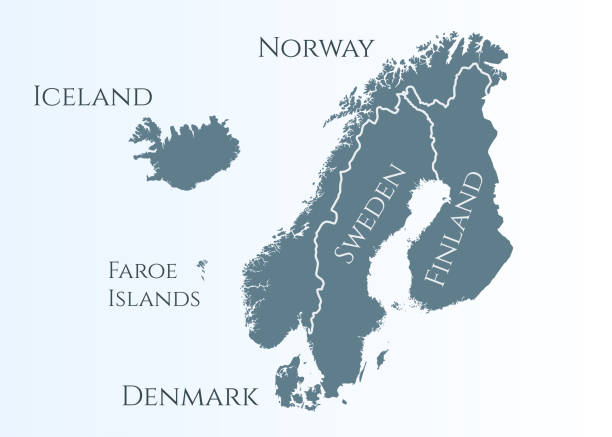Scandinavian countries refer to the three Northern European countries of Norway, Sweden, and Denmark. These countries are known for their stunning natural beauty, rich cultural heritage, and strong social welfare systems. This article explores the geography, history, and culture of the Scandinavian region, delving into the unique characteristics of each country and the similarities they share.
Geography of the Scandinavian Region
Norway
Norway is a long and narrow country located in Northern Europe. It is bordered by Sweden to the east and Finland to the northeast, and shares its northern border with the Arctic Ocean. Norway is famous for its stunning fjords, mountains, and glaciers, and is home to the highest peak in Northern Europe, Galdhøpiggen. Norway’s coastal areas are dotted with small fishing villages and its interior is dotted with forests and lakes.
Sweden
Sweden is located in Northern Europe and is bordered by Norway to the west and Finland to the northeast. It is the third-largest country in the European Union by area, with a diverse landscape that includes forests, lakes, and mountains. Sweden’s largest lake, Vänern, is the third-largest lake in Europe, and its largest mountain range, the Swedish Lapland, is home to some of the most rugged and wild terrain in the country.
Denmark
Denmark is a small country located in Northern Europe and is bordered by Germany to the south and Sweden to the east. It is home to many picturesque islands, including the island of Funen, which is known for its rolling hills and fertile farmland. Denmark is also known for its stunning coastline, which is dotted with sandy beaches, cliffs, and lighthouses.
History of the Scandinavian Region
Norway
Norway has a rich and fascinating history, dating back to the Viking Age, when the country was home to many powerful warriors and seafarers. Norway was first unified as a kingdom in 872 and became a part of the Kalmar Union in 1397, which united the kingdoms of Denmark, Norway, and Sweden under one ruler. Norway gained independence from Sweden in 1905 and is now one of the world’s wealthiest and most prosperous countries.
Sweden
Sweden has a rich and fascinating history, dating back to the Viking Age, when the country was home to many powerful warriors and seafarers. Sweden became a great power in the 17th and 18th centuries and was one of the dominant powers in Europe during the Thirty Years’ War. Sweden was also a founding member of the European Union and remains one of the most prosperous and economically stable countries in the world today.
Denmark
Denmark has a rich and fascinating history, dating back to the Viking Age, when the country was home to many powerful warriors and seafarers. Denmark was a major power in Northern Europe for centuries, and was a dominant player in the Northern Wars of the late 16th and early 17th centuries. Denmark also played a major role in the formation of the European Union and remains one of the most prosperous and economically stable countries in the world today.
Culture of the Scandinavian Region
Norway
Norway has a rich and diverse cultural heritage, with a strong focus on traditional folk arts and crafts. The country is known for its stunning fjords and rugged terrain, which have inspired many artists, writers, and musicians over the years. Norway is also known for its strong social welfare system, which provides a high quality of life for its citizens, and is a major player in the global environmental movement, with a strong focus on sustainable development and environmental protection.
Sweden
Sweden has a rich and diverse cultural heritage, with a strong focus on the arts and education. The country is known for its stunning landscapes and vibrant cultural scene, which have inspired many artists, writers, and musicians over the years. Sweden is also known for its strong social welfare system, which provides a high quality of life for its citizens, and is a major player in the global environmental movement, with a strong focus on sustainable development and environmental protection.
Denmark
Denmark has a rich and diverse cultural heritage, with a strong focus on the arts, design, and architecture. The country is known for its stunning coastline, picturesque villages, and vibrant cultural scene, which have inspired many artists, writers, and musicians over the years. Denmark is also known for its strong social welfare system, which provides a high quality of life for its citizens, and is a major player in the global environmental movement, with a strong focus on sustainable development and environmental protection.
Scandinavian Design and Architecture
The Scandinavian countries are known for their iconic design and architecture, which is characterized by a focus on simplicity, functionality, and natural materials. This style of design is often referred to as “Scandinavian Modern,” and it emerged in the mid-20th century as a response to the ornate, decorative styles that were popular in Europe at the time.
Norway, for example, is home to many iconic buildings that embody this style of design, including the Oslo Opera House and the National Museum of Art, Architecture and Design. Sweden is also known for its iconic architecture, including the Stockholm City Hall, which was designed by Ragnar Östberg, and the Stockholm Public Library, which was designed by Gunnar Asplund.
Denmark is also renowned for its iconic design and architecture, with many buildings that embody the Scandinavian Modern style, including the Copenhagen Opera House and the Royal Danish Theater. Finland is home to many iconic buildings as well, including the Helsinki Central Railway Station, which was designed by Eliel Saarinen, and the Helsinki Olympic Stadium, which was designed by Yrjö Lindegren and Toivo Jäntti.
Iceland is also known for its iconic design and architecture, with many buildings that embody the Scandinavian Modern style, including the Reykjavik Concert Hall and Conference Center, which was designed by Henning Larsen Architects, and the Harpa Reykjavik Concert Hall and Conference Center, which was designed by Olafur Eliasson and Henning Larsen Architects.
Conclusion
In conclusion, the Scandinavian countries of Norway, Sweden, and Denmark are some of the most prosperous and economically stable countries in the world, and are renowned for their rich cultural heritage, iconic design and architecture, and stunning natural beauty. With a focus on sustainability, social welfare, and equality, these countries offer a high quality of life for their citizens, and continue to play a major role in shaping the future of Europe and the world.
Bibliography
- “Denmark – Culture and Society.” Denmark.dk, The Kingdom of Denmark, 2021, denmark.dk/en/living-in-denmark/danish-culture-and-society.
- “Finland – Culture.” Lonely Planet, 2021, lonelyplanet.com/finland/culture.
- “Iceland – Culture and Society.” Iceland.is, The Official Gateway to Iceland, 2021, iceland.is/the-big-picture/culture-and-society.
- “Norway – Culture and Society.” Norway.no, The Official Gateway to Norway, 2021, norway.no/en/about-norway/norwegian-society/culture-and-society.
- “Scandinavian Design.” Design Museum, 2021, designmuseum.org/design/scandinavian-design.
- “Sweden – Culture and Society.” Sweden.se, The Swedish Institute, 2021, sweden.se/culture-and-society.
- “The Scandinavian Model: An Overview.” Institute for New Economic Thinking, 2019, ineteconomics.org/perspectives/blog/the-scandinavian-model-an-overview.
- “The Scandinavian Social Model: Is It Sustainable?” OECD, 2021, oecd.org/sweden/the-scandinavian-social-model-is-it-sustainable.html.
- “The Cultural Heritage of Norway.” Visit Norway, 2021, visitnorway.com/places-to-go/fjords/the-cultural-heritage-of-norway.
- “The Cultural Heritage of Sweden.” Visit Sweden, 2021, visitsweden.com/experience/heritage.
- “The Cultural Heritage of Denmark.” Visit Denmark, 2021, visitdenmark.com/denmark/history-culture-heritage.
- “The Cultural Heritage of Finland.” Visit Finland, 2021, visitfinland.com/article/the-cultural-heritage-of-finland.
- “The Cultural Heritage of Iceland.” Visit Iceland, 2021, visiticeland.com/culture/heritage.
- “Scandinavian Architecture: An Overview.” Architecture Design, 2021, architectureanddesign.com.au/features/scandinavian-architecture-an-overview.
- “The Iconic Architecture of Norway.” Visit Norway, 2021, visitnorway.com/places-to-go/fjords/the-iconic-architecture-of-norway.
- “The Iconic Architecture of Sweden.” Visit Sweden, 2021, visitsweden.com/architecture.
- “The Iconic Architecture of Denmark.” Visit Denmark, 2021, visitdenmark.com/denmark/architecture.
- “The Iconic Architecture of Finland.” Visit Finland, 2021, visitfinland.com/article/the-iconic-architecture-of-finland.
- “The Iconic Architecture of Iceland.” Visit Iceland, 2021, visiticeland.com/architecture.



 For all latest articles, follow on Google News
For all latest articles, follow on Google News